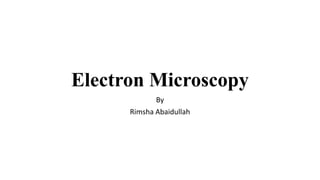
Lec 3; Microscopy ALI.pptx
- 2. Electron Microscopy The source of illumination for an electron microscope is a beam of electron. The resolution of electron microscope is between 2-4 Angstrom.It means we can differentiate two points that are 2-4 Angstrom apart. It makes the object 500X greater than the compound microscope and 250,000 greater than the naked eye. The electrons make the limit of resolution very small. The wavelength of an electron decreases as its velocity increases.
- 4. Commonly used Electron Microscopes 1. Transmission Electron Microscope (TEM) 2. Scanning Electron Microscope (SEM)
- 5. Transmission Electron Microscope TEM is a microscopy technique whereby a beam of electrons is transmitted through an ultra-thin specimen. Beam of electrons at high speed is directed towards specimen and after interaction it passes through it. Image is magnified and focused onto an imaging fluorescent screen such as photographic film or detected through CCD camera
- 7. Structure of TEM 1. Electron Gun And Condenser System: The electron gun produces the electron beam. A tungsten filament is placed in the electron gun as a source of electron. The condenser system focuses the beam onto the object. Condenser: The intensity and angular aperture of beam are controlled by condenser lens system. It is present between the gun and the specimen.
- 8. 2. Image Producing System: It consists of objective lens, moveable specimen stage and projector lenses. They focus electrons passing through the specimen to form a real, highly magnified image 3. Image recording system: It consists of a fluorescent screen for viewing and focusing the image and a digital camera for permanent records. Fluorescent screen is fitted at the base of the microscope column.
- 9. TEM Working i. Vacuum System: To direct electron beam to pass through the EM-lenses and strike specimen ii. Electron Emission Source: At 100-300kV electrons are generated from tungsten / lanthanum hexaboride iii. Electromagnetic Lenses and plates: To direct and manipulate the electron beam as required iv. Sample holder & Insertion device: To hold and insert the sample into the column while maintaining the vacuum v. Imaging Device: To generate & display image from transmitted beam of electrons
- 10. Specimen Preparation for TEM 1. Fixation: Fixative (Chemical Products) are used that denature or precipitated the cellular macromolecules 2. Sample Staining: The most widely used stains in electron microscopy are the heavy metals. Osmium Tetroxide is a good fixative and excellent stain for lipids in membranous structures and vesicles.
- 11. 3. Dehydration: Specimen is dehydrated by incubation in a series of ethanol or acetone solutions. Solvent concentration is increased gradually so that water is removed gently, without causing shrinkage. 4. Embedding in resin: Following dehydration, the solvent is replaced with a gradually increasing concentration of liquid resin (typically epoxy resin for ultrastructure studies). The specimen is placed in a mold filled with liquid resin and cured into a hard block using heat or UV light. After this, a sample can be stored indefinitely.
- 12. 5. Ultra-thin sectioning: A specimen embedded in hardened resin can be sectioned extremely thinly, at less than 100 µm. This is done using ultra microtome.This allows for the electron beam to pass from the electron gun through the specimen to the detector. The sections are mounted on specimen grids which fit into microscope sample holder. 6. Contrasting (poststaining): Biological specimens are naturally not very electron opaque as they are composed of atoms with low atomic numbers and the beam passes through them easily.
- 13. To increased ample contrast, the sections can be post-stained with lead citrate. This heavy metal salt, similarly to osmium tetroxide and uranyl acetate, binds to cell components and scatters the incident beam electrons. The areas of specimen section which scatter electrons more are recorded as darker pixels, which stand out against the brighter background.
- 14. Sample insertion for TEM
- 15. Limitations of TEM i. Extensive Sample Preparation: Range of consumables and chemicals required ii. Ultra-Thin Sectioning: Very difficult part of sample preparation, diamond coated ultra- microtome blades required & skillful handling to perform iii. Time Consuming: Relatively longer time required upto weeks for sample preparation completion iv. Large Number of Samples to be Imaged: A single field of view may not yield conclusive results
- 17. SCANNING ELECTRON MICROSCOPE SEM is a microscopy technique whereby a beam of electrons is used to scan a sample. Electrons interact with the atoms that make up the sample, producing signals that contain information about sample topography, composition and related properties.
- 18. SEM Composition
- 19. SEM Working Electron beam is generated from electron gun (tungsten wire) Beam acceleration by the Anode Electron beam focusing by controlling the electromagnetic fields and lenses towards the specimen Scanning the specimen surface by a mechanism of deflection coils (Raster pattern) Production of Secondary electrons (SE) , Back Scattered electrons (BSE) and X-Rays Detectors in imaging region convert SE, BSE and X-rays into signals and corresponding images are generated
- 21. Working
- 24. SEM Analysis Reveals Topography: Surface features of an object and its texture Morphology: The shape and size of the particles making up the object Composition: Elements and compounds that the object is composed of and relative amount of them • Numbers of BSE depends on the atomic number of element and hence helps to distinguish between different phases, providing image with sample’s composition information. Crystallographic Information: The arrangements of the atoms in the object Cu atoms scatter more electrons back towards detector than the lighter aluminum atoms
- 25. SEM Sample preparation Cleaning surface of Specimen Stabilizing / Fixing the Specimen Rinsing the Specimen Dehydration Coating the Specimen
- 26. Limitation of SEM Artifacts during sample preparation. No absolute way to eliminate or identify all potential artifacts Conductive Specimen needed Expensive metals for sample preparations
- 27. Transmission Electron microscope scanning Electron microscope